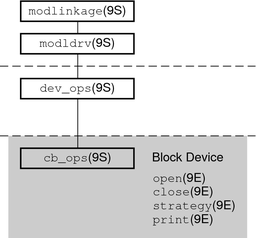| Skip Navigation Links | |
| Exit Print View | |

|
Writing Device Drivers Oracle Solaris 11.1 Information Library |
| Skip Navigation Links | |
| Exit Print View | |

|
Writing Device Drivers Oracle Solaris 11.1 Information Library |
Part I Designing Device Drivers for the Oracle Solaris Platform
1. Overview of Oracle Solaris Device Drivers
2. Oracle Solaris Kernel and Device Tree
5. Managing Events and Queueing Tasks
7. Device Access: Programmed I/O
10. Mapping Device and Kernel Memory
13. Hardening Oracle Solaris Drivers
14. Layered Driver Interface (LDI)
Part II Designing Specific Kinds of Device Drivers
15. Drivers for Character Devices
Block Device Autoconfiguration
open() Entry Point (Block Drivers)
close() Entry Point (Block Drivers)
Synchronous Data Transfers (Block Drivers)
Asynchronous Data Transfers (Block Drivers)
Checking for Invalid buf Requests
Handling the Interrupting Device
dump() and print() Entry Points
dump() Entry Point (Block Drivers)
print() Entry Point (Block Drivers)
18. SCSI Host Bus Adapter Drivers
19. Drivers for Network Devices
Part III Building a Device Driver
22. Compiling, Loading, Packaging, and Testing Drivers
23. Debugging, Testing, and Tuning Device Drivers
24. Recommended Coding Practices
B. Summary of Oracle Solaris DDI/DKI Services
C. Making a Device Driver 64-Bit Ready
Figure 16-1 shows data structures and routines that define the structure of a block device driver. Device drivers typically include the following elements:
Device-loadable driver section
Device configuration section
Device access section
The shaded device access section in the following figure illustrates entry points for block drivers.
Figure 16-1 Block Driver Roadmap

Associated with each device driver is a dev_ops(9S) structure, which in turn refers to a cb_ops(9S) structure. See Chapter 6, Driver Autoconfiguration for details on driver data structures.
Block device drivers provide these entry points: